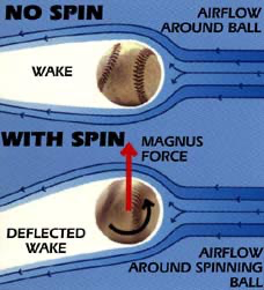Over the last decade of baseball there has been an explosion in the use of technology and analytics to define or redefine the game as we know it. Along with this growth has come, what seems like, a whole new language that coaches are having to learn in order to communicate with the modern player. This blog series is aimed at simplifying some of this language to hopefully create a bridge between those that consider themselves “old school” and the “new age” coaches who have adapted and learned this new language.
Spin Rate: Simplified
In the simplest of terms, Spin Rate is the how fast the ball is spinning as the pitcher releases the pitch. When a pitch is thrown, there are many factors that go into how it moves, how it creates shape and how a hitter will potentially react to it once it enters the zone. Modern coaches use tracking technology like Rapsodo or Trackman to measure this spin in revolutions per minute or RPM along with defining how useful that spin is in creating the desired pitch.
Physics of Why

Defining How A Ball Spins
You don’t have to be a scientist or a “nerd” to understand the simplicity of spin rate. As a ball is released from the hand it has the potential to spin in 3 different directions. The X Axis is simply defined as the left-right spin and vice versa. The Z Axis is simply defined as top-bottom spin and vice versa. The Y Axis is simply defined as gyroscopic spin. An easy way to think of gyroscopic spin is to imagine throwing a football towards the catcher and defining the direction the football is spinning. The images below attempt to help visualize how a ball spins as it is released in relation to the terms used to define that spin.


Key Points To Remember:
- X Axis = Left and Right Spin
- Z Axis = Top and Bottom Spin
- Y Axis = Football Spin
Not All Spin Is Created Equal
Depending on the pitch type thrown there are more desirable spin directions and speeds that must be understood. There are two types of spin that are created when throwing a baseball. There is “useful spin” which Alan Nathan describes as “transverse” spin and “gyroscopic spin” which we defined earlier. Transverse or “useful spin” directly influences ball movement and on most pitch types, is a desirable characteristic. Gyroscopic spin has little to no influence on ball movement and is thus a less desirable characteristic on most pitch types. We will discuss where it can be useful in a second.
Key Points To Remember:
- Transverse Spin (Useful Spin) = Direct Influence On Ball Movement
- Gyroscopic Spin (Not Useful) = No Influence On Ball Movement (Useless)
How Efficient Is It Spinning
Now that we understand the concept of spin rate and the direction the ball can spin, let’s talk about how we determine how efficient a thrown ball is spinning. When a device like Rapsodo and Trackman measures a ball’s spin rate it gives us two readings that we should be aware of: overall spin rate, measured in RPM (revolutions per minute) and spin efficiency measured as a percentage. Spin efficiency is defined as how consistent, or inconsistent, a ball spins along a certain axis.
Key Points To Remember:
- Total Spin = Measured RPM Along All 3 Axes Of Rotation (X,Y,Z)
- True Spin = Total Spin Minus The Measured Gyroscopic Spin
- Spin Efficiency = Relationship Between True Spin and Total Spin
Applying Spin Rate To Pitch Movement
Let’s take all that we have learned so far and apply it to pitch movement. Generally speaking, most fastballs, changeups and curveballs have a desired spin efficiency as close to 100% as we can get. This means that the ball is spinning consistently along the same axis of rotation which will yield the most consistent air flow around the ball to determine movement. As the air flows around the baseball, it experiences a phenomenon known as the Magnus Effect. As the ball spins in a certain direction, it creates areas of high pressure and low pressure that will impact ball flight. Additionally, the baseball is going to fight the force of gravity as it tries to pull the ball towards the ground on its way to the catcher. For fastballs, the back spun baseball will fight gravity with the low-pressure pocket above the ball and a high-pressure pocket below the ball trying to keep it aloft on its path to the glove.

For curveballs, the top spun nature of the pitch will create an inverted low-pressure pocket which will force the ball to “break” downward with the aid of gravity. The more efficient a curveball is spun and the higher the rpm, the sharper the break tends to be. Hopefully you now understand the basic principles of how spin affects ball movement.

Key Points To Remember:
- Most Fastballs, Curveballs and Changeups = As close to 100% spin efficiency as possible
- Back Spun Pitches Will Try To Create Lift
- Top Spun Pitches Will Create Drop
- Tilt Of The Ball Out Of The Hand Can Explain How Pitches Move
Sliders And Gyro Spin
In the previous section we attempted to explain how creating efficient spin is important for fastballs, curveballs and some changeups. But what about sliders? The short answer is, it’s complicated. But that is why we are here, so let’s try and dissect this as simply as possible.
In general, most sliders will have significantly more gyroscopic spin than transverse spin. You may have heard the concept of picking up the dot on a slider.

By adding a little bit of transverse spin, a slider will begin to take on various movement characteristics based on the axis of this additional spin. If you were able to perfectly spin a ball, like a bullet, of your hand with 0% efficiency, there would be no horizontal movement to the pitch on the way to the plate however that pitch will begin to fall vertically as it is creating no lift. By adding as little as 15%-25% transverse spin, the pitch begins to create the appearance of a slider. The axis by which you are adding this spin will begin to define the overall shape of the pitch, both vertically and now horizontally.
There are many different kinds of sliders that a pitcher can throw. Some have a vertical break (Think Brad Lidge) and some create a more sweeping horizontal break (Think Adam Ottavino).


The different break characteristics can be attributed to different release points and different axes that the balls are spinning on. Lidge averaged 1.25” of horizontal break and 0.74” of vertical break on his slider over his career while Ottavino has so far averaged 5.98” of horizontal break and -0.12” of vertical break on his. On Lidge’s slider, we can make the assumption that his slider has less transverse spin which allows for him to create more vertical movement while on Ottavino’s slider we can make the assumption his slider carries more transverse spin which allows for a bigger sweeping action.
Ideal sliders are difficult to define because they come in so many different variations based on arm slot and spin. When developing a slider, it is fair to assess the pitch based not only on movement, but also on how it fits in with the rest of the athlete’s repertoire. Some athletes have a difficult time creating the right amount of transverse spin to create a big enough sweep to make it an effective pitch while other athletes will find themselves adding too much transverse spin and creating more a slurve which would be halfway between the vertical characteristics of a curveball and the horizontal characteristics of a slider.
Key Points To Remember:
- Most sliders will have more gyroscopic spin vs transverse spin
- Sliders come in all shapes and sizes and are difficult to define
- Ideal slider spin efficiency is somewhere between 15%-25%
Measuring Spin Without Technology
Measuring spin with the aid of technology that costs thousands of dollars in definitely a luxury for most coaches, programs and facilities. While they are becoming more popular within the world of baseball, they may be financially out of the wheelhouse for some. So, can you still measure spin rate without the use of expensive technology? The answer is yes but with some limitations.
Early on in our facility’s existence, we didn’t have the means to invest in Rapsodo so we went the low tech way. Most everyone has a very capable cellphone in their pockets these days. Most of these modern cellphones have a slo-mo feature shooting upwards of 240fps (frames per second). By simply drawing a thick black line on a baseball in various directions and a solid dot on the sides you can use your phone, and these marked up baseballs to see how consistent a ball is spinning in various directions. 
Summary
Hopefully by reading through this blog, we have made it easier for you to understand the basics of spin and spin-rate. There are definitely more advanced concepts when it comes to spin and how it effects ball flight but we want to try and keep it as simple as possible to understand. Coaches should not be afraid of spin or just write it off as a useless technological measurement. While the eyes do tell us quite a bit, having a little bit of advanced knowledge can be a difference maker between and average pitch and an elite pitch.




